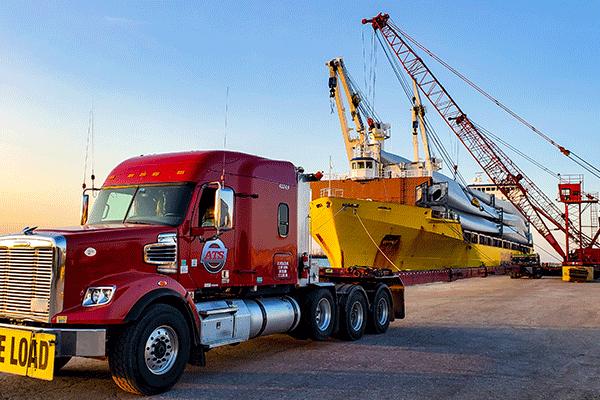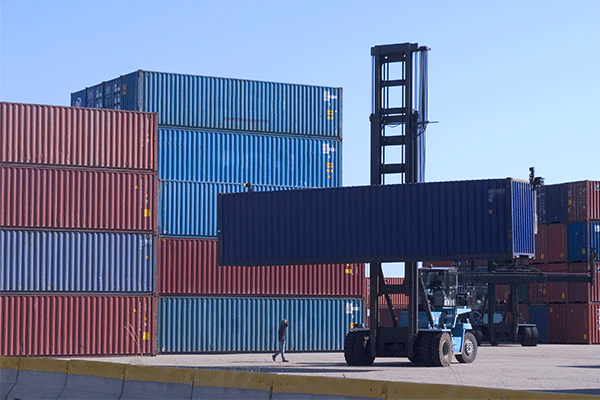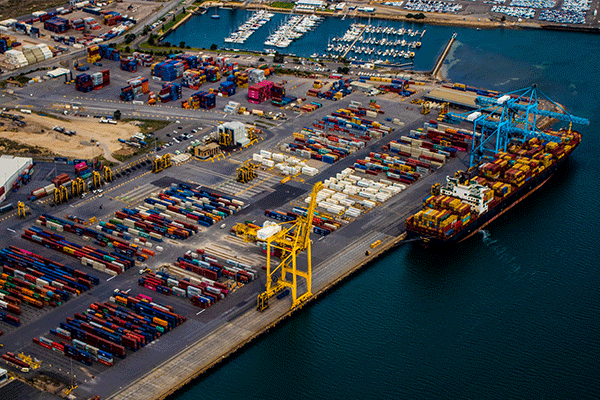
You’ve routed your shipment through a U.S. port before and know that doing so provides its own set of unique fees and challenges. The services provided to your shipment at the port can become expensive and you want to make the most of your budget.
Here at ATS, we’ve been working with ports across the globe for decades which is why we understand your challenges. Without transparency and knowledge of the potential fees involved, your shipping budget can quickly get out of hand.
In this blog, we’ll explain:
- What port services are
- How these services impact the price you pay
- What you can do to make the most of your international shipping dollars.
What Are Port Services?
Port services are the activities taken to move cargo within a port upon arrival.
These services are exercised in two instances:
- As soon as a shipment arrives at the terminal located at its port-of-loading (POL) in preparation for export.
- When a shipment arrives at its port-of-discharge (POD) upon the completion of its ocean voyage.
Any company that imports or exports goods does so with the knowledge that their freight will end up within a port, or multiple ports, along the way.
Since the beneficial cargo owner (BCO) of this freight isn’t located on-sight at these ports, these services are vital in making sure that the freight is handled, transferred, transshipped, relocated and ready for the remainder of its journey.
All freight routed through a port is handled by third-party workers employed by the port. These workers are vital to ensuring the successful transit of freight from point A to point B and are typically given one of these titles:
What Are Longshoremen?
longshoremen are the individuals tasked with transporting freight onto and off of a vessel or barge at commercial ports. Longshoremen are a vital piece of the freight shipping process as they coordinate with trucking companies to distribute and sort commodities to facilitate a smooth process.
Duties include, but are not limited to:
- Operating complicated equipment to load/offload and transfer freight
- Loading and unloading cargo into/from its container
- Working with all stakeholders (ship crews, truck drivers, stevedores) to facilitate a smooth freight shipment process.
What Are Stevedores?
Similar to Longshoremen, Stevedores are the individuals or firms that manage the operation of loading and unloading a vessel. These highly skilled workers must understand the correct methods for loading and stowing freight for oceanic travel.
Duties include, but are not limited to:
- Properly securing freight using
- Chains
- Marine shrinkwrap
- Welding solutions
- Loading/Offloading and transferring freight using:
- Port cranes
- Roll trailers
- Mafi Trailers
- Forklifts

In some cases, freight must be transported to an offsite location as stipulated by the receiving party. In these instances, port workers are charged with the responsibility of loading the freight onto the truck where it will continue the remainder of its journey.
Here are some examples of common port services and associated charges that shippers and consignees should keep in mind:
- The services of on-sight crews
- Loading and offloading vessels
- Securing cargo
- Operating marine cranes
- Loading and offloading trucks
- Customs clearance services
- Short-term warehousing
- Equipment Demurrage
- Port Detention
There are more than 360 commercial ports located across the U.S. and thousands more spanning the globe. As such, each of these ports offers different services at varying price points. Some offer warehousing services, some offer customs clearance and others have crane operators onsite for larger shipments.
Which services are used completely depends on the type of freight that’s being transported, which port it ends up in and any special instructions attached to its BOL.
Additionally, since the pricing of each of these services is highly variable from one port to another, the importance of consulting with your freight forwarder regarding your specifications can’t be overstated. Doing so will give you a better understanding of which services you’ll need so that you’re able to stick to your schedule and maintain your bottom line.
How Do Port Services Impact Shipping Price?
These services, although important for on-time arrivals, aren’t offered free of charge. As such, if you’re a shipper who needs to move freight overseas, you’ll want to plan for the cost of handling your product during its time at the port.
Although the price of these services varies from one port to the next, there are five common charges that — when not properly monitored — can significantly impact your bottom line.
These service charges are:
- Port Detention Charges
- Equipment Demurrage Charges
- Truck Detention Charges
- Drayage charges
- Terminal Charges
Port Detention Charges
If a shipment is left in its port of origin or destination for an extended period, the charges for this occupied space can become hefty. These charges — called port-detention charges — are some of the most common service charges that shippers and consignees incur when routing freight through a port.
However, by using a seasoned freight forwarder, port detention fees can be avoided.
Here’s how:
Every shipment when it arrives at the port is given a designated amount of “free time.” This is the length of time the shipment is allowed to sit idly in the port, free of charge.
Although this timeframe varies depending on the port, country and size of shipment, freight is generally given between a couple of days to a week of “free time” upon arrival.
Port detention charges only start becoming an issue as soon as a shipment surpasses its final allotted “free day” at the port. From there, detention charges increase as time goes by in the hopes of motivating these companies to get their freight moved.
By using a freight forwarder with a demonstrated history of successfully routing freight through international ports, avoidable detention charges can be eliminated.
Equipment Demurrage Charges
Another common charge associated with international cargo shipping is the equipment demurrage charge. These are charges levied by the owner of the cargo containers or other specialized equipment assets required to move the cargo.
Usually, equipment demurrage charges are exercised on a per-container/equipment basis for every day that the asset is utilized longer than the “free time” stipulated by the freight tariff.
Like port detention charges, these fees increase substantially as time goes on.
Working with a great transportation provider will help you to avoid this charge as they understand your timeframes and know how to meet them.
Related Content: Container Demurrage vs. Container Detention: What's the Difference?
Truck Detention Charges
Often, ports are humming with activity. Ships are arriving, trucks are moving in and out and crews are working double-time to make sure all freight ends up in the right place. As such, the amount of time it takes for a driver to get loaded or unloaded is difficult to control.
Because of this, detention charges are levied with frequency as it takes longer to get a truck loaded/unloaded. Since truck drivers are only allowed to be actively on duty for a designated period (14 hours within a 24 hour period) they must be compensated for the time they lose while sitting at the port.
Truck detention charges have become increasingly common in recent years as the Coronavirus forces ports to operate with limited workers, slowing loading times.
As such, you must ask your logistics provider how truck detention charges will impact your international shipment.
Related Content: 5 Things to Understand When Making Pickup Arrangements for Your Port Freight
Drayage Service Charges
Drayage charges are fees for the localized transportation of freight either between ports, from its port of discharge or to its port of loading.
This means that if your freight needs to be transported to a nearby transloading facility or prearranged warehouse, drayage service charges will be added to the final cost of your shipment.
For less-than-container load (LCL) shipments, these charges are calculated based on the amount and weight of the freight in question. For full container transport, these drayage fees are exacted by the specific requirement and distance of the move.
Terminal Charges
The final category of port service charges that you’ll want to plan for are the charges incurred throughout the handling, processing, loading and offloading of freight while at the port. These terminal charges directly relate to the type, quantity and specifications of your freight.
Terminal charges are quoted to the party responsible for paying them in many different ways, depending on their role in the process.
Here are four terms that you must know if you’d like to understand how terminal charges are incorporated into international freight rates:
Liner in (LI): The freight rate quoted to the shipper includes all of the cargo handling and loading fees incurred at the POL.
Liner Out (LO): The freight rate quoted to the receiver includes all of the cargo handling and unloading fees incurred at the POD.
Free In (FI): The term used when the handling of the cargo at its POL isn’t included in the initial rate quoted to the shipper.
Free Out (FO): Whenever the loading and handling of cargo at its POD isn’t included in the initial freight rate quoted to the receiver.
Partnering with an experienced freight forwarder will help you understand your freight rate as it relates to Liner In/Liner Out and Free In/Free Out services.

How to Make the Most of Your Port Shipping Budget?
Getting the most from your port shipping budget comes down to having diligent communication and transparency between you and your transportation partner.
Make sure that you understand these key things:
- When is your shipment arriving at the port?
- When is your shipment’s last free day?
- When will your truck arrive at the port?
- Do you need to find a warehousing service for your freight?
- Will drayage services impact your pricing?
- What services will you require within the port?
Clearly and accurately understanding the answers to these key questions will help you plan for a smooth freight movement process.
It’s also imperative to decide who’s in charge of paying for any port service charges ahead of time so that when the time comes to pay the bill, no one is confused. This will also ensure that unforeseen charges don’t pop up and impact your pricing.
In the end, saving money in this process will be easiest if you find a reliable logistics partner and providing them the proper lead time to get your transportation pieces in place.
Ask your potential provider:
- What is your history working with port shipping services?
- How will port charges impact my shipments?
- What can I do to make this process as smooth as possible?
The answers your potential partner provides to these questions will help you determine whether they’re a good fit for your freight shipment’s needs.
If you’d like to know more about how ATS can help you with your next international port shipment, let’s talk.




